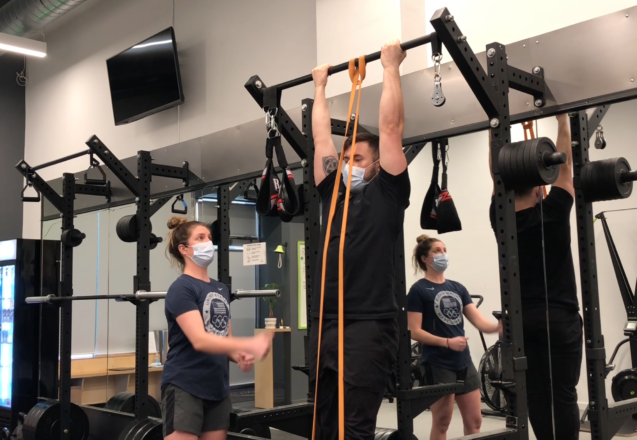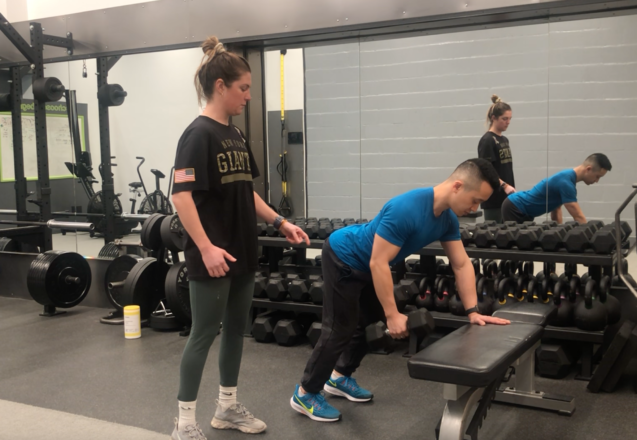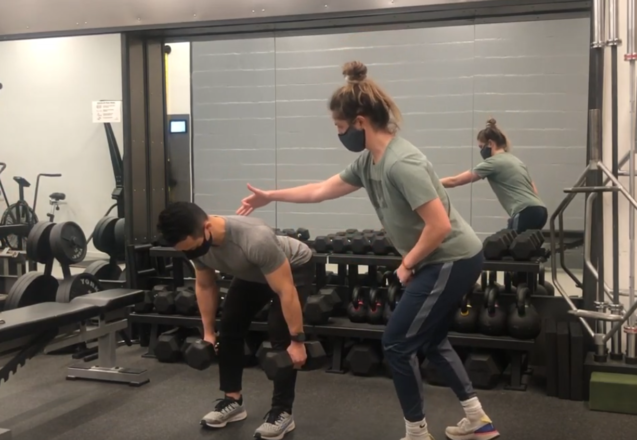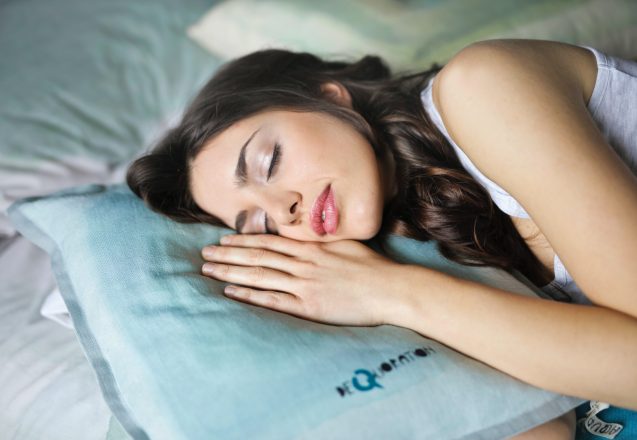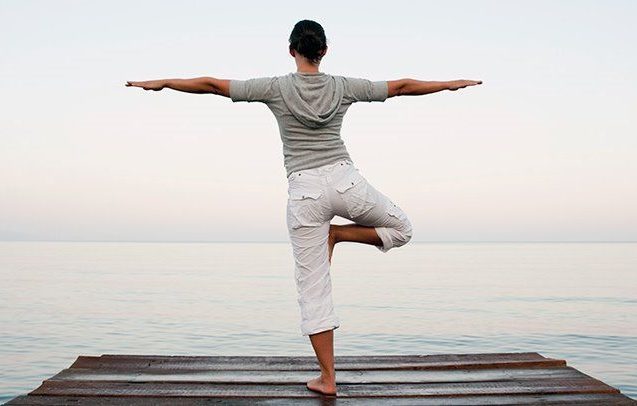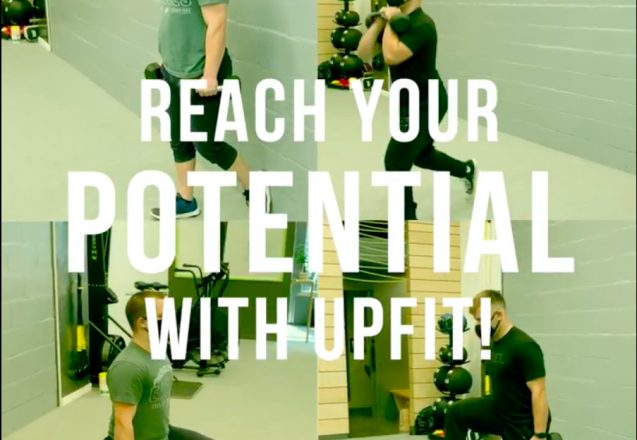Learn to Jump at UpFit
In this post I will be teaching you proper jumping form. Jumping movements are a good way to get your heart rate up while also working on balance, strength and explosiveness. It is important that you know the correct technique when introducing a jumping pattern into your program to minimize the risk of injury and create max force output. I have broken down the movement into 3 simple drills to get you started on your jumping journey!
The first movement is the drop squat. Here you will be learning proper landing technique. This movement can be used in various exercises, like squat jumps or the overhead med-ball slam we commonly use here at UpFit. It is important with this movement to learn how to absorb the force when you are landing to prevent injuries when you start doing more advanced movements.
Our second movement is the jump squat with counter movement. This is a progression from the drop squat so make sure you have that movement down before advancing to the jump squat with counter movement. This movement is important because here’s where you’re going to learn to absorb the power from the drop squat and use it to explode up.
Our final movement is the continuous jump squat. This is the most advanced movement of the three. At this step you will be combining the first two movements (the drop squat and jump squat with counter movement) absorbing and creating force one right after the other.
How to Build Up Your Chin Up
Have you ever set a chin up (or pull up) goal for yourself but eventually fell short because it seemed too difficult or tedious? Do you watch videos of people doing chin ups and wonder how they “make it look so easy”?
If this sounds like you, you’re far from alone–plenty of people want to become better at chin ups. Majority of their success (and yours), comes from how you choose to approach the task. Simply attempting to do chin ups from a dead hang position is not your best bet here.

Make sure to start at a dead hang, as seen here.
That being said, there are various ways in which you can develop a better chin up. One of our go-to methods here at Upfit is the assisted chin up. The assisted chin up is great because it not only allows you to work through the entire range of the motion, but it also requires a good deal of core strength to do the exercise effectively.
One big variable in this exercise is the degree of tension in the resistance band you choose. Needless to say, the tighter the band, the more assistance it will offer & the easier the chin up will be. You want to find a happy medium in terms of resistance–not too easy but not extremely difficult…realistically you want to aim for 12-15 reps for this exercise.

Getting your chin completely above the bar allows you to reach the full range of motion.
Once the band is secured above your pull up bar you will start by putting either one or two feet in the loop of the band and allow yourself to drop enough so that your arms become fully extended.
From there you will brace your core and begin your chin up, finishing when the chin is completely above the bar & your shoulder blades are drawn down and your upper back is fully engaged. It’s important to note here that each rep should end in the dead hang position, arms fully extended.
After you have the proper form down & understand the full range of the motion, you’ll want to aim for 12-15 reps and 3-4 sets. Once you have hit that rep/ set range successfully for 3-5 weeks, depending on your frequency, you can begin to lower your resistance and eventually build up to body weight chin ups.
The Viking Push Press with Landmine
The Viking push press is a vertical push exercise that uses the entire body to complete the movement but the main focus is the shoulders. Clients with shoulder or low back pain can benefit from this exercise instead of a standard military press because the viking press allows you to keep a neutral spine without hyperextending the lumbar. You can train the whole strength spectrum with the Viking Press You can train for maximum strength( ≥ 85% for fewer than 6 repetitions), power production ( 80-90% for 1-2 reps), hypertrophy (70-85% for 6-12 reps).
The client should stand with feet shoulder width apart and soft knees while holding the handle with a neutral wide grip at shoulder height.
The first part of the movement is going to be the “dip”. Performing the dip slowly and controlled will ensure that no energy is wasted. During this stage you will also want to stabilize the torso by keeping the chest tall, push the knees out and hips back.
The next part of the movement is the ”drive”. During this part of the movement power produced in the lower body will be transferred through the torso generated through the extension of the ankle, knee and hip. Your legs and hips are the main movers at this stage.
The final step is the “press”. This is when the upper body comes into play. Using the momentum from the “drive” the client is going to lean in, bring the head forward and push the handle straight up overhead with arms in complete extension, exhaling at the top. At the end of the movement of the body should be in perfect alignment, back straight leg straight and locked out in arms fully locked out. Even though the body will be lean forward the body should be in a perfect line.
Strengthen Your Back and Core
Rowing is one of the best exercises with a handful of variations & applications. No matter your experience level, you’ll be sure to benefit from some form of this exercise whether it be with resistance bands, dumbbells, kettlebells, or a barbell. Regardless of what equipment you have available to you the fundamentals remain the same.
In addition to the type of resistance variations, there are also several positions in which you can perform this exercise– here, I will break down the 3-point stance row using a dumbbell. At UpFit, we love this variation because it helps people develop a better hinge for deadlifts and a better brace to strengthen the hip and core muscles for performance. This particular variation has an anti-rotational component that forces you to tighten up the deeper core and hip muscles in order to maintain trunk and hip stability.
To start off you will want to make sure you have a sturdy surface about thigh height to support your non-working arm. Make sure your feet are really planted into the ground & squared up to your bench, a little wider than shoulder width apart. With your back flat and head in a neutral position, place the dumbbell on the ground in front of you.
From here you will grab the dumbbell and start the row, pulling that elbow all the way back while trying to keep your shoulders square to the bench. It’s important to note here that the dumbbell should not be stopping at chest height, but rather closer the hip. Once you’ve reached the full range of the motion, you’ll begin to lower the weight back to center.

As seen above, the hinge position is key to performing this exercise effectively.
Once you’ve got the proper form down, try to get about 12-15 reps per side & aim for around 2-4 sets. Again, there’s a fair amount of variations with this exercise, so once you have mastered the fundamental movement you can begin to play with different resistance and positioning.
The Contagion of Exercise
Can’t seem to keep an exercise routine? Your friends probably think the same.
by: Paul W. Park M.S. CSCS
A client of mine was the first person in her family to start making exercise a priority in her life. As a physician, she knew the health benefits, mental and physical, of living a physically active lifestyle, but it was difficult for her to make it part of her normal routine.
Not surprisingly, her chats at work weren’t about weekend workouts, (sorry doctors, you guys are notoriously bad at consistent exercise). So she sought help outside of her social network, a different social network of trainers/coaches and exercise enthusiasts. Fast forward a few years later, her husband and mother-in-law train regularly a few days a week, their family goes on weekly bike rides, and new brutal exercises that I have her husband do has become normal dinner conversation.
During this once in a century pandemic, while the forefront of our minds is on the spread of a biological virus, we must not forget the ability of metaphysical things such as ideas, principles, and habits to spread. Our social networks, through which these ideas spread, have more influence over our behaviors than most of us give credit for. Did most of your friends quit smoking? Your chances of kicking the habit increase. (1) Trying to lose some weight? Embarking on this challenging task with a group of friends rather than alone will increase your chances of not only losing weight, but keeping it off in the long term. (2) Free will is a concept that we hold dear to our hearts, and yet many of us fail to reach our weight loss or fitness goals. We blame our lack of discipline and willpower, but don’t fully consider the effects of the social environment that we are a part of.
Our biological drive to be part of a social network is sometimes lost within the individualistic culture that is touted in western society. Try serving carnitas tacos to a devout Jewish family or wearing a Yankee hat into Boston’s Fenway park, and you will understand the strength of social ties on behavior. Like a school of fish traveling in a coordinated, almost rehearsed like fashion, our social networks are human superorganisms, as explained by Christakis and Fowler (3) in their book Connected, that alter and change our everyday behaviors more than we give credit for.
“Seeing ourselves as part of a superorganism allows us to understand our actions, choices, and experiences in a new light. If we are affected by our embeddedness in social networks and influenced by others who are closely or distantly tied to us, we necessarily lose some power of our own decisions. Such a loss of control can provoke especially strong reactions when people discover that their neighbors or even strangers can influence behaviors and outcomes that have moral overtones and social repercussions. But the flip side of this realization is that people can transcend themselves and their own limitations” (3, p. xii).
Can we leverage this power of our social networks to transcend the dearth of physical activity that we are facing today? An example 30 years ago showcases how a change in normal social behavior dramatically changed the health of our country (4). Smoking indoors was widely considered the norm, with tobacco advertisements showing smiling good looking doctors were common. In time, research showed the health detriments of being a smoker, and the government aptly recognized and regulated the industry. Now normal is having to go outside in the cold huddled together with one possible friend or two. In effect smoking is no longer considered the social norm that it once was, as inactivity and overconsumption could be considered the norm today.
Comparing the norms of smoking and inactivity however is like apples to oranges; it does not illustrate the increased effort and strategy it will take to unseat inactivity. Our evolutionary biological drive is to conserve energy; for most of our history on this planet, we did not know when we would get our next meal. This drive to conserve and overconsume strengthened by social norms of inactivity will require more than simple government guidelines. Unlocking and leveraging the power of our superorganism-like social networks, and our tendency to be affected by those around us is the key to fighting the sedentary crisis.

We are all connected
Walking around New York City and then visiting Miami can give us an appreciation for the power of social networks. Appropriate to the current times, Manhattanites are much more likely to wear masks than those of the more conservative counties of Florida (5). The collective attitude of New Yorkers is to wear masks. It makes sense to us. I suspect walking around without a mask in New York will get you looks of disapproval and judgement, while in Florida a contrasting laissez faire attitude of “Not everyone is doing it, so why do I need to?” will probably be the norm.
The best chance we have of encouraging physical activity is to make it normal and commonplace. To have a person’s immediate social circle be involved in a weight loss journey can improve that person’s chances of long term weight maintenance. Even having the social support of strangers embarked on the same struggle can make a difference (2). There is evidence of true groups, team workouts with group dynamic principles that were designed to increase cohesiveness, increasing exercise program adherence rates over standard exercise classes (6). If we can develop a sense of collectivism and community, participants are more likely to stick to an exercise program. This is a part of how Crossfit became popular in the 2010’s, the togetherness of a group of exuberant exercisers cheering each other on as each push and suffer through excruciating discomfort.
While our tendency to be affected by others can be leveraged to create health promoting behaviors, there’s also evidence for the spread of unhealthy ones. Christakas and Fowler analyzed data from the Framingham Heart Study, and found that obesity spread just like a physical virus (7). “If a person’s friend became obese, it increased the likelihood that he/she would become obese by 57%, with larger effects found for same- sex friends. If a person’s sibling became obese, he/she was 40% more likely to become obese, with larger effects again seen for same-sex relationships. If a person’s spouse became obese, he/she was 37% more likely to become obese” (8, p. 412).
An example for this sort of spread could be your friends starting to drop out of that running program you guys decided to start on together. Further, those same friends instead invite you out for happy hour for drinks and bar food. There is an increased chance of you choosing french fries and beer over a workout class full of strangers.
When firefighters deal with forest fires, they use controlled fires to deter and combat the spreading flame. With evidence of the obesity epidemic spreading through our social networks along with a cultural tendency for sedentarism, the “fight fire with fire” analogy is appropriate, and starts with understanding and accessing the transcendent ability of our social networks. This is a call for those seeking lifestyle change as well as for exercise professionals to start understanding and leveraging a new global social network oriented approach, an all encompassing approach that considers the forest for its trees.
If you are personally looking to keep an exercise habit, consult and spend more time around those who live the lifestyle you are looking to live. Get to know the people in your exercise class or gym as this will increase your chances of coming back. At the very least it will make it much easier to say no to that happy hour if you know there is a friend looking forward to seeing you in class. Ask your friends to join you for walks, hikes, or even exercise classes. Sometimes people are just looking for an invite. The next new exercise contagion, just like ripples of a thrown rock in water, can start with you!

Fun all around!
For coaches and trainers, consider how one on one training might not promote the adherence benefits that come with group training. If you are already doing group training, try to find ways to get people working together rather than just next to each other. This can be done through team workout challenges or attendance accountability challenges. At UpFit Training Academy, by issuing a 6 week attendance challenge at the start of 2021, we saw an improvement in attendance from an average 7.2 classes per participant in 2020 to an average 10.7 classes per participant in 2021. A team like dynamic promoted within the training can be the difference in whether a new trainee becomes consistent, sees results and therefore sticks with an exercise program.
Last but not least, our public health policy makers must start realizing the connectedness and relevance of social networks for creating positive health habits and exercise. The US is by far the leading spender of health care costs compared to our peer nations, and yet has one of the lowest life expectancy rates (9). High profiled politicians leading with and promoting their own exercise routines can also have tremendous downstream social effects. While exercise is likely not the only determinant factor (food industry/nutrition), we can only imagine a vastly different outlook of the most recent pandemic if a culture of movement and an appreciation of exercise was the norm. A consistent exercise and movement practice will create a more resilient and healthy country (10), and the collective rising tide of our social networks is one of the keys to lifting every person’s individual health boats.
References:
- Christakis, Nicholas A., Fowler, J. H. (1008). Quitting in Droves: Collective Dynamics of Smoking Behavior in a Large Social Network. New England Journal of Medicine, 358(21), 2249–2258. https://doi.org/10.1056/NEJMsa0706154
- Wing, R. R., & Jeffery, R. W. (1999). Benefits of recruiting participants with friends and increasing social support for weight loss and maintenance. Journal of Consulting and Clinical Psychology, 67(1), 132–138. https://doi.org/10.1037//0022-006x.67.1.132
- Christakis, N. A., & Fowler, J. H. (2009). Connected (1st ed.). Little, Brown and Company
- Lori M. Millner, Mark W. Linder, and R. V. J. (2019). Measuring the Impact of the Reduction in Tobacco Smoking on US Lung Cancer Mortality, 1975–2000: An Introduction to the Problem. Physiology & Behavior, 176(3), 139–148. https://doi.org/10.1111/j.1539-6924.2011.01745.x
- Igielnik, R. (2020, June 23). Most Americans say they regularly wore a mask in stores in the past month; fewer see others doing it. Pew Research. https://www.pewresearch.org/fact-tank/2020/06/23/most-americans-say-they-regularly-wore-a-mask-in-stores-in-the-past-month-fewer-see-others-doing-it/
- Burke, S., Carron, A., Eys, M., Ntoumanis, N., & Estabrooks, P. (2006). Group versus individual approach? A meta-analysis of the effectiveness of interventions to promote physical activity. Sport and Exercise Psychology Review, 2(1), 19–35.
- Christakis, N. A., & Fowler, J. H. (2007). The Spread of Obesity in a Large Social Network over 32 Years. New England Journal of Medicine, 357(4), 370–379. https://doi.org/10.1056/nejmsa066082
- Smith, K. P., & Christakis, N. A. (2008). Social networks and health. Annual Review of Sociology, 34, 405–429. https://doi.org/10.1146/annurev.soc.34.040507.134601
- Tikkanen, R., and Abrams, M.K. (2020, January 30). U.S. Health Care from a Global Perspective, 2019: Higher Spending, Worse Outcomes?. The Commonwealth Fund. https://www.commonwealthfund.org/publications/issue-briefs/2020/jan/us-health-care-global-perspective-2019
- Wood, T. R., & Jóhannsson, G. F. (2020). Metabolic health and lifestyle medicine should be a cornerstone of future pandemic preparedness. Lifestyle Medicine, 1(1), 1–5. https://doi.org/10.1002/lim2.2
Knee dominant squat vs. Hip dominant squat
A squat is a common movement that we use in our everyday life. As trainers we incorporate this movement to make everyday living easier for our clients. For example, getting up out of a chair or getting something from a lower cabinet. There are many variations of this exercise. You can use a barbell to back squat or front squat, use dumbbells to suitcase squat, or a kettlebell to goblet squat. Today I will be covering the kettlebell goblet squat and the differences between making it a knee dominant exercise verses a hip dominant exercise.
When performing a goblet squat the client should begin with their feet shoulder width apart and toes slightly turned out. The client should then bring the kettlebell up to about chest height holding it with both hands and squeezing the elbows close to their sides, activating the lats . Standing up nice and tall, the client should brace their core and take a deep breath in as they begin to squat. As the client is squatting they want to keep their chest up nice and tall and “spread the floor” by driving the knees outward. The client will then push through the floor to stand up engaging the hamstrings and glutes and exhaling at the top.
Key things that you will notice about the Knee dominant squat is that the clients torso will be more upright, toes facing forward, weight in the heels and a greater shin angle. Because of this positioning we will be working our anterior muscles such as your hip flexors and quadriceps. In the hip dominant squat the clients torso will be a little more forward, toes slightly turned out, weight in the mid foot and a lesser shin angle, activating the posterior chain (glutes, hamstrings, spinae erectors, & calves)
Building Your Perfect Deadlift With Upfit
by: Emma Bolton
Over the last year or so, most people have either maintained or increased their time spent behind a computer screen. While some of us may enjoy the fact that the screen is within the walls of our own homes, this doesn’t necessarily help to spark our motivation to get up and move throughout the day. With increased periods of sitting or just overall stagnation our bodies become used to these recurring patterns of movement, or lack thereof; que tight hip flexors, lower back pain, or even sore middle back, upper back, and shoulders.
That being said, there are some simple exercises you can add to your routine in order to get you out of your current positioning and hopefully allow you to feel less stiffness or tightness throughout your body. One key exercise that has a variety of benefits is the deadlift.
Nailing down the correct postural components of the deadlift will be applicable to a wide variety of common movements. Therefore, by understanding the proper components of this exercise, you will start to see how you can apply it to your day to day life. So, let’s break it down…
For the sake of this discussion, I will be using the dumbbell (DB) Romanian deadlift, although it could be similarly replicated with a barbell, trap bar, resistance band, etc.
We will start at the foundation of the movement–the ground. Ideally, you should have feet about shoulder width apart and a relatively neutral foot position (not sitting back in your heels but also not leaning too much into your front foot).

Notice how his knees come to complete extension at the top of the movement.
From there we will move upwards to the knees. Here, we’re looking for a slight bend, not so much so that we enter a squat position but enough to start to engage your glute muscles. Taking it up to hips, here is where a lot of our focus should be. Unlike a squat, the hinge movement that we see in a deadlift requires the hips to sit back in space rather than drop towards the floor. This will require work from primarily the hamstrings & glute muscles (hip stabilizers), with the help of surrounding core muscles.
Lastly, in regards to the upper body the biggest thing we’re looking for here is neutrality. What do I mean by this? To put it simply, you should be able to draw a straight line from your pelvis up to the back of your head, being sure not to tuck your chin too much, or overly extend at the neck either.
Now that we have touched on the various focal points of the movement, let’s put it all together. You’re going to start with the DB’s facing laterally at about hip height. With arms locked out and your lat’s engaged, you’re going to start that hinge movement by gliding those hips backwards, keeping in mind those glutes & hamstrings. When you’ve reached the bottom of the movement (feeling a decent stretch in those hamstrings), you will then bring those hips forward using primarily your glutes & hamstrings. Upon reaching that top position, you should be focusing on your breath– timing your exhale as you hit that top point (standing straight up, DB’s at your hips).

Here, you’ll notice the improper positioning of his ribs as he reaches the top with his ribs flared out.
Finally, there are a few points to be aware of. One, there is a tendency to try and engage lower back muscles here. If that’s the case, I would recommend performing these with just body weight to start, that way you can be sure to recruit the proper muscles and not worry about overloading any improper recruitment of muscles. Second, although there is a fair amount of upper body usage throughout this exercise, it is a primarily lower extremity movement. When you start to get comfortable with this movement and begin to add weight, it’s important to note that you are not “pulling up” the weight with your upper body, but rather using the floor and your legs to leverage the weight up.
Better Sleep Naturally with These 5 Steps
by: Paul Park M.S. CSCS
The most fit and healthy people in the world realize that it’s not the extraordinary actions done every so often, it’s the ordinary actions done consistently.
Water, movement, nutritiously dense foods, and….sleep!
If I had one cookie cutter remedy to instantly improve your fitness and health, for most people it would be just that, to spend more time in dreamland.
The benefits of consistent restful nights of sleep are far reaching leading to endless downstream effects. From overall energy, mood, strength, endurance, skin health, and cognitive sharpness; there’s a reason why we spend a big bulk of our lives in the land of Z’s. Matthew Walker’s book Why We Sleep is a great reference for those who want to dive into the research, and learn all about the benefits of a great night’s sleep.

She knows how to sleep!
“Yeah I know Paul, you’re preaching to the choir! I know I should get a good night’s sleep, I just can’t seem to do it. It takes me forever to fall asleep and when I do it’s always spotty.”
It’s a hard deal! The modern world hasn’t exactly made it easier either.
From artificial lighting that let’s us rarely experience natural darkness (1), the constant access and demand of our work and bosses (2), to electronics that emit light and notifications that beg for our attention (3), it’s no wonder we are more sleep deprived than ever before. The Center for Disease Control and Prevention (CDC) reported 35.3% of US adults getting less than the recommended 7 hours of sleep in 2009. In addition, those people were more likely to unintentionally fall asleep during the day than those who got 7 plus hours of sleep (46.2% vs 33.2%).
Some of us even have the best intentions going to bed at a reasonable hour. It’s actually falling asleep without tossing and turning that can be the problem for many. I know I’ve had those nights, a big day ahead of me knowing I need to be my charming, energetic self. 2 hours later into a counting sheep session, I’m wondering how I could “fake it till I make it” during tomorrow’s three back to back group training sessions.
After some research, trial and error, and realizing how much more patience, energy, physical strength, and cognitive wit I had after consistent restful nights of sleep, I was able to whittle it down to 5 simple things. If I consistently made them a part of my routine, it would almost always lead to me falling asleep and staying asleep effortlessly.
Keep a consistent sleep wake schedule
Our body’s feeling of sleepiness and wakefulness is determined by something called a circadian rhythm. The natural rise and fall of certain hormones underlie when we wake up and when we feel like we need to hit the hay. When our circadian rhythm falls into a predictable and consistent routine, the more likely we are to fall asleep faster and easier (4). So try going to bed and waking up at the same time everyday, even on the weekends, and you’ll find your body starting to feel sleepy at a predictable time almost everyday. To take it to the next level, try to train your body to wake up without an alarm clock!
Get sunlight during the day
Our circadian rhythm is impacted largely by lightness and darkness. The light feedback that our eyes get through our retina tells our brain that it is daytime, and that we need to be awake and alert (3). While most us might think we get enough light throughout the day, a majority of that light can come from artificial lighting. Artificial lights, while seeming bright, fall at lower intensities than natural sunlight, and do not induce the same feedback in our brains as the sun does (3).
See if you can spend at least 30 minutes a day getting sunlight, or at least sit by the windows in your office. Even on a cloudy day it can make a difference! (5)
Limit electronics in the evening (or at least right before your bedtime)
Netflix, Instagram, Facebook, E-mail. All enthralling sources of entertainment, work, and seemingly an everyday part of our modern lives. While there is debate over whether or not our smartphones and these platforms are negatively impacting our mental health, the blue light that emits from our devices has been shown to suppress our melatonin levels (6). Melatonin is the hormone responsible for giving our body the sense of sleepiness. However, this effect on our melatonin seems to be temporary, as studies show a recovery to normal levels within 15 min from cessation of exposure (6). Takeaway: try to stay away from electronics close to your bedtime, but if you must check your email, do so away from your bedroom and your bed.
Limit caffeine past noon
As a fitness business owner, and one who regularly coaches 6am training sessions, coffee is and certainly will always be my best friend in the mornings. The cognitive and athletic performance enhancing effect is undeniable, as coffee is one of most commonly consumed drinks throughout the world. However past 12pm, while tempting, a second cup of coffee risks me having trouble sleeping that same evening. Try to avoid coffee and caffeine products in the afternoon, as it’s been shown to have disruptive effects on our sleep (7).
Exercise
I am certainly biased, but exercise is a catch all intervention for poor sleep as it handles its many intrinsic facets. The act of intentionally improving one’s health waterfalls into other habits such as avoiding alcohol and poor foods which negatively impact our sleep. That daytime run you’ve been meaning to try out? It will expose you to that sunlight needed (as mentioned above) to keep our circadian rhythm consistent and happy. There is also a bidirectional effect of exercise on sleep, as you are more likely to sleep when you exercise, and also more likely to exercise when you sleep (8, 9). The relationship between these two can not be understated! The biggest effects seem to come from exercise lasting more than an hour anytime during the day, but no closer than 2 hours before your bedtime (10).
There you have it, 5 natural ways of improving your chances of falling and staying asleep. While supplement and drug companies promote bandage solutions of prescribing pills and medicines, most of us will benefit from first making these 5 strategies a part of our daily routines. If you’ve had the awareness to compare your performance, mood, energy, and general grade as a human being from a good vs. bad night of sleep, and you know it is something that you want to improve, try out these 5 strategies. Your body, health, and fitness will certainly benefit, as you will be better prepared to handle the stresses of your life, and give your brain the power to tackle the new challenges of 2021!
References:
- Wright, K. P., McHill, A. W., Birks, B. R., Griffin, B. R., Rusterholz, T., & Chinoy, E. D. (2013). Entrainment of the Human Circadian Clock to the Natural Light-Dark Cycle. Current Biology, 23(16), 1554–1558. https://doi.org/10.1016/J.CUB.2013.06.039
- Foster, R. G., & Wulff, K. (2005). The rhythm of rest and excess. Nature Reviews Neuroscience, 6(5), 407–414. https://doi.org/10.1038/nrn1670
- Blume, C., Garbazza, C., & Spitschan, M. (2019). Effects of light on human circadian rhythms, sleep and mood. Somnologie, 23(3), 147–156. https://doi.org/10.1007/s11818-019-00215-x
- Goel, N., Basner, M., Rao, H., & Dinges, D. F. (2013). Circadian rhythms, sleep deprivation, and human performance. Progress in Molecular Biology and Translational Science, 119, 155–190. https://doi.org/10.1016/B978-0-12-396971-2.00007-5
- Figueiro, M. G., Steverson, B., Heerwagen, J., Kampschroer, K., Hunter, C. M., Gonzales, K., Plitnick, B., & Rea, M. S. (2017). The impact of daytime light exposures on sleep and mood in office workers. Sleep Health, 3(3), 204–215. https://doi.org/10.1016/j.sleh.2017.03.005
- Tähkämö, L., Partonen, T., & Pesonen, A. K. (2019). Systematic review of light exposure impact on human circadian rhythm. Chronobiology International, 36(2), 151–170. https://doi.org/10.1080/07420528.2018.1527773
- Drake, C., Roehrs, T., Shambroom, J., & Roth, T. (2013). Caffeine effects on sleep taken 0, 3, or 6 hours before going to bed. Journal of Clinical Sleep Medicine, 9(11), 1195–1200. https://doi.org/10.5664/jcsm.3170
- https://www.npr.org/transcripts/705224359
- Kline C. E. (2014). The bidirectional relationship between exercise and sleep: Implications for exercise adherence and sleep improvement. American journal of lifestyle medicine, 8(6), 375–379. https://doi.org/10.1177/1559827614544437
- Driver, H. S., & Taylor, S. R. (2000). Exercise and sleep. Sleep Medicine Reviews, 4(4), 387–402. https://doi.org/10.1053/smrv.2000.0110
A great way to build balanced lower body strength!
A great way to build balanced lower body strength!
Knee Dominant Unilateral Progression
UpFit Training Academy
Jacob O’Connor, Brian Santanelli
Personal training and group fitness programs often take advantage of unilateral movements. Unilateral is just our way of saying using one side of the body at a time. These movements require a degree of balance and insure each side is working independent of the other. This prevents strength discrepancies which can lead to discomfort, pain, and injury! A priority of any personal training or small group program is to keep you healthy, which is why you might see a lot of these movements. These exercises a great for keeping your legs, hips, and back feeling strong and pain free!
Some of our favorite knee dominant unilateral movements can be found below. Enjoy!
Split Squat
Lateral Squat
Bulgarian Split Squat
Forward Lunge
Sliding Lateral Lunge
These are some of the best knee dominant unilateral movements out there. Utilizing these exercises is a sure fire way to strengthen those legs, improve balance, and improve joint health! If you’ve been dealing with discomfort and can’t seem to find relief these just might be the key for you. We hope these help you to get out of discomfort and into balanced movement!
It’s Time to Strengthen Your Strongest Joint
It’s Time to Strengthen Your Strongest Joint
The Importance of Hip Strength and Stability
UpFit Training Academy
Jacob O’Connor, Brian Santanelli
The importance of strong and stable hips cannot be overemphasized. Whether it be for performance, aesthetics, or general health the hips should be a focus for the majority of personal training programs. The hips produce more force than any other joint in your body, this is where your greatest strength is stored!
The hips are integral for almost every lower body movement such as walking, jumping, squatting, and running. They are also essential for balance keeping us on our feet and assisting in movements such as twisting and throwing. Weakness or instability in the hips can negatively impact one’s low back, core, and lower body. Unfortunately, many of us do not have optimal hip movement many times due to a sedentary lifestyle. Unilateral movements do a great job of preventing uneven strength and development because they strengthen one side at a time. Here are some of our favorite unilateral hip exercises, we hope you enjoy!
DB Reverse Lunge
This movement is loaded with dumbbells held at one’s side. While maintaining a slight lean forward at the torso participants will step backward into a lunge creating a 90 degree angle at both knees. It’s important to keep the hips underneath the body throughout the lunge. Reps can be alternated or done on each side individually.
DB Step Up
Dumbbell step ups are also loaded with dumbbells held at the side. Participants will step onto a bench or step driving through the front leg until fully extended. It’s important to make sure the entire foot is mounted onto the implement before stepping. The same leg used to step up will be used to lower the body back to the starting position.
KB Front Rack Reverse Lunge
This movement is very similar to the dumbbell reverse lunge, the difference being how the exercise is loaded. The KB front rack reverse lunge is loaded with two kettlebells held in a front rack position. Because of the difference in loading, it’s important to emphasize tension in the upper body and a tall chest throughout each rep.
Kickstand RDL
The kickstand RDL is loaded using dumbbells or kettlebells at each side. One foot will be against the wall, the heel of this foot will remain on the wall throughout the exercise. While maintaining tension in the upper back and lats participants will hinge forward towards the front leg. The kickstand RDL should be felt in the front hamstrings. Common mistakes include setting up too far away from the wall, letting the back heel come off of the wall, and losing tension in the upper body.
Walking Lunge
A staple in many personal training regimens, the walking lunge is loaded with dumbbells or kettlebells held at one’s side. Participants will lunge forward creating a 90 degree angle at each knee and keeping the hips stacked underneath the body. You can choose to reset between each rep or reps can be linked together in a fluent walk.
These exercises are great examples of movements you can do to strengthen your strongest joint! Prioritizing the hips can take your personal training or small group program to the next level. Taking advantage of unilateral variations is great for the hips as it’s not uncommon to see asymmetries in this area. Unilateral variations also have the added demand of balance which is important for all of us. These are simple movements that can be done with minimal equipment at home, we hope you try them out and enjoy!

